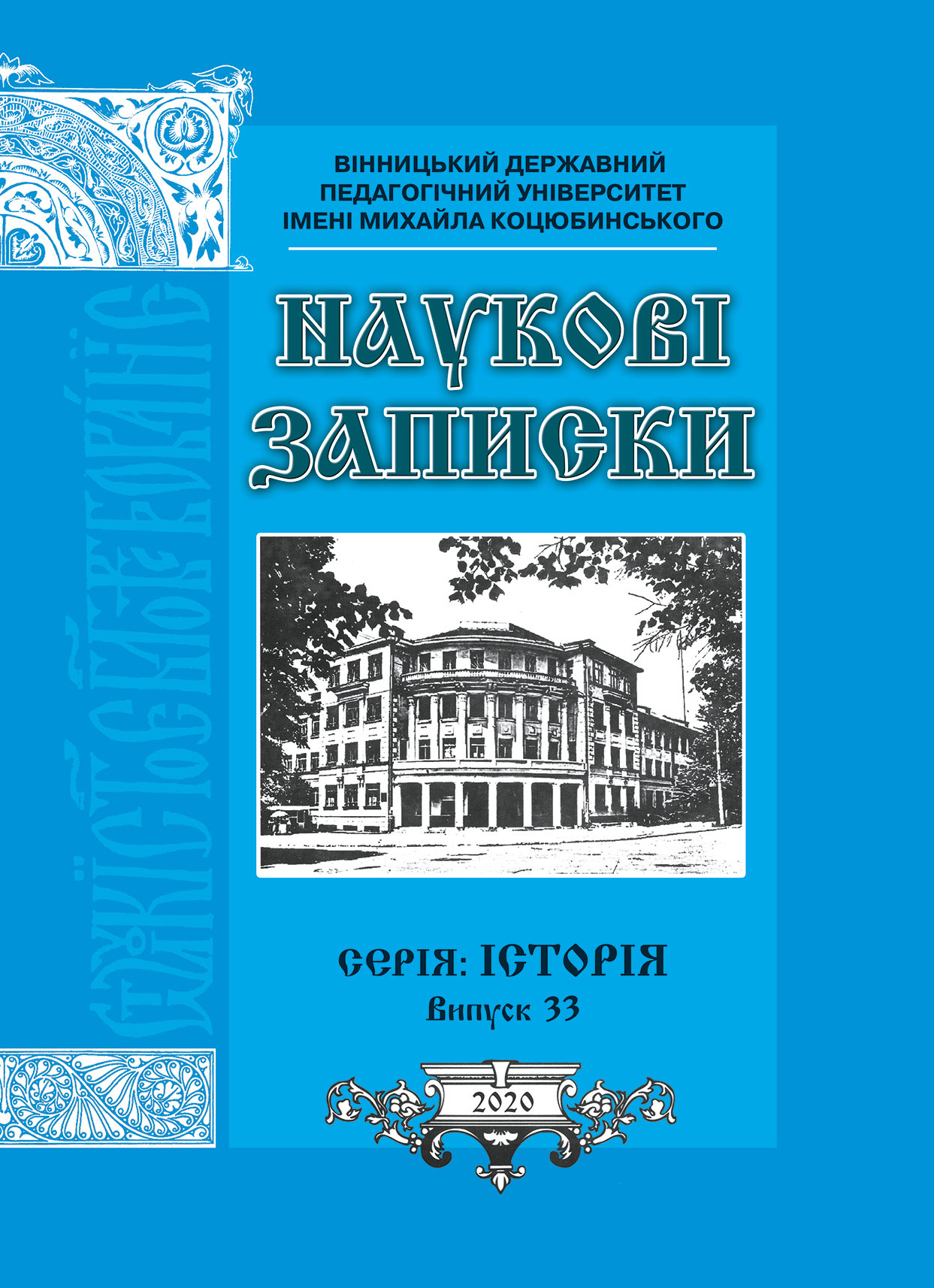Abstract
The purpose of the article is to outline the scale of the tossing of newborn children in sub-Russian Ukraine in the end of 19th – early 20th centuries, to determine the causes of this phenomenon, the participation of the state and the public in caring for social orphans and measures to combat this deviation. The methodology of the research is based on a combination of general scientific (analysis, synthesis, generalization, comparison, systematization) and special-historical methods (historical-structural, constructive-genetic, historical-comparative) with the principles of objectivity, historicism, and consistency. Scientific novelty of the work lies in the fact that for the first time in domestic and foreign historiography the problem of foundlings in the Russian Empire of the end of 19th – early 20th centuries (on the example of the sub-Russian Ukraine) is comprehensively considered, including the reasons for the throwing of children, the scale of this phenomenon is outlined, the effectiveness of state and public institutions in caring for social orphans is determined. Conclusions. Tossing children is a natural phenomenon for a society that is going through the processes of modernization and urbanization. It is based on socio-economic and psychological factors. Population growth in the Russian Empire and sub-Russian Ukraine in particular, which became possible as a result of the abolition of serfdom in 1861, the completion of the industrial
revolution in the 1880s, the active development of capitalism, the spread of emancipation movements and trends in the development of Western culture in society, legal prostitution status, etc. caused the degradation of the institution of marriage and the beginning of the devaluation of the family as the basis of a patriarchal society. The overwhelming majority of mothers leaving their children to fend for themselves are rural girls who could not find a high-paying job in the city, became victims of fraudsters and gentlemen. At the end of the 19th century, local governments (zemstvos) and public organizations took an active part in the creation of orphanages. The state did not have time to centrally respond to new challenges of society and did not carry out work to prevent the throwing of children. Police work was ineffective. The high morbidity and mortality of foundlings in orphanages were caused by an unsatisfactory level of medical care and excessive bureaucratization of the state apparatus.
References
Ransel, D. L. (1976). Abandoned children of imperial Russia: village fosterage. Bulletin of the History of Medicine, Vol. 50, No. 4, 501–510.
А. И. (1875). Вопрос о незаконнорожденных. СПб : Типография и Литография А. Траншеля, 75 с.
Акушерка Турченко. (1904). Киевлянин, 11 января, 6.
Брошенный ребенок. (1900). Волынь, 20 июня, 2.
Галайба, В. (2018). Из жизни губернского Киева. Киев : Скай Хорс, 320 с.
Губительница детей. (1901). Киевлянин, 1 августа, 2.
ДАЖО – Державний архів Житомирської області.
Девочку. (1906). Волынь, 25 марта, 1.
Детские приюты в 1900 году. (1902). Киевлянин, 1 ноября, 2.
Детский приют имени Императора Александра ІІ. (1898). Киевлянин, 13 июня, 2.
Для беременных. (1904). Волынь, 25 августа, 4.
Для усыновления. (1903). Киевлянин, 14 января, 6.
Желаю взять ребенка. (1903). Киевлянин, 2 января, 6.
Зайцева, С. В. (2008). Земские учреждения и подкидыши в конце ХІХ века. Вестник Ленинградского государственного университета им. А. С. Пушкина. 2 (История), С. 20–33.
Киевский Мариинский детский приют. (1898). Киевлянин, 23 июля, 2.
Кругляк, М. Е. (2019). Соціальний статус підкинутих дітей у Російській імперії наприкінці ХІХ – на початку ХХ ст. (на прикладі Волинської губернії). Вісник НТУУ «КПІ». Політологія. Соціологія. Право, 3, С. 88–93. https://doi.org/10.20535/2308-5053.2019.3(43).195687
Лебедина, О. (2020). Українці відмовилися в 2019 році від 326 новонароджених дітей. https://zn.ua/ukr/UKRAINE/u-moz-nazvali-skilki-v-ukrajini-ditej-vidmovnikiv.html
Макаров, А. (2018). Беды, язвы и пороки старого Киева. Киев : Скай Хорс, 336 с.
Миронов, Б. Н. (2000). Социальная история России периода империи (XVIII – начало ХХ в.) (в 2 т., Т. 1). СПб. : Изд-во «Дмитрий Буланин», 548 с.
Обзор Волынской губернии за 1885 год. (1886). Житомир : Губернская Типография, 136 с.
Обзор Волынской губернии за 1909 год. (1910). Житомир: Волынская Губернская Типография, 162 с.
Обзор Волынской губернии за 1910 год. (1911). Житомир: Волынская Губернская Типография, 160 с.
Обзор Волынской губернии за 1911 год. (1912). Житомир: Волынская Губернская Типография, 180 с.
Оставленный ребенок. (1901). Киевлянин, 19 марта, 3.
Отчет по ведомству детских приютов. (1898). Киевлянин, 3 декабря, 3.
Ошанин, М. (1912). О призрении покинутых детей. Ярославль : Типолитография Губернской Земской Управы, 284 с.
Подбрасывательницы детей. (1903). Киевлянин, 16 марта, 3–4.
Подкидыш. (1898a). Волынь, 11 марта, 2.
Подкидыш. (1898b). Киевлянин, 7 августа, 3.
Подкидыш. (1906). Киевлянин, 27 сентября, 3.
Подкинутые дети. (1898a). Киевлянин, 19 апреля, 3.
Подкинутые дети. (1898b). Киевлянин, 10 августа, 3.
Подкинутый и возвращенный ребенок. (1898). Киевлянин, 1 апреля, 4.
Подкинутый ребенок. (1898). Киевлянин, 12 июля, 3.
Призрение бесприютных детей и подкидышей. (1897). Волынь, 18 февраля, 2.
Ребенок новорожд. (1904). Киевлянин, 18 сентября, 6.
Родильный приют. (1909). Волынь, 22 сентября, 1.
Середюк, Н. (2017). У Львові знайшли неживе немовля. «Вікно життя» наразі відновлювати не будуть. http://tvoemisto.tv/news/u_lvovi_u_korobtsi_znayshly_mertve_nemovlya_83978.html
Сиротский дом. (1898a). Волынь, 10 марта, 3.
Сиротский дом. (1898b). Волынь, 17 марта, 3.
Сиротский дом. (1899). Волынь, 10 ноября, 2.
Сиротский дом. (1900). Волынь, 16 декабря, 2.
Скорик, Т. (ред.). (2010). В Україні щороку меншає відмов від новонароджених дітей. https://www.ukrinform.ua/rubric-society/959660-v_ukran_shchoroku_mensha_vdmov_vd_novonarodgenih_dtey_891634.html
Судебные уставы 20 ноября 1864 года, с изложением рассуждений, на коих они основаны, изданные Государственною Канцеляриею. (Часть 4). (1867). СПб : Тип. Второго Отделения Собственной Е.И.В. Канцелярии, 200 с.
Усадьба Александровского детского приюта. (1898). Киевлянин, 12 июня, 3.
Фабрика ангелов. (1902). Киевлянин, 16 марта, 3.
Фабрикация ангелов. (1903). Киевлянин, 13 января, 3.
Шашков, С. С. (1872). Исторические судьбы женщины, детоубийство и проституция. СПб : В тип. Ф. С. Сущинского, 585 с.
Шевченко, Н. (2013). В Україні за 8 років втричі знизилася кількість дітей, від яких відмовилися батьки – до 566 випадків на рік. https://zn.ua/ukr/UKRAINE/chislo-vidmov-vid-novonarodzhenih-ditey-v-ukrayini-zmenshilosya-vtrichi-122817_.html
Шкрабʼюк, В. С. (2013). Відмова від материнства як психологічна проблема. Теоретичні і прикладні проблеми психології, 3, С. 304–309. https://doi.org/10.33216/2219-2654
Янжул, И. (1870). О незаконнорожденных. Статистико-юридический очерк. Москва : В Унив. Тип., 80 с.

This work is licensed under a Creative Commons Attribution 4.0 International License.
Copyright (c) 2020 Scientific Papers of the Vinnytsia Mykhailo Kotsiubynskyi State Pedagogical University. Series: History





